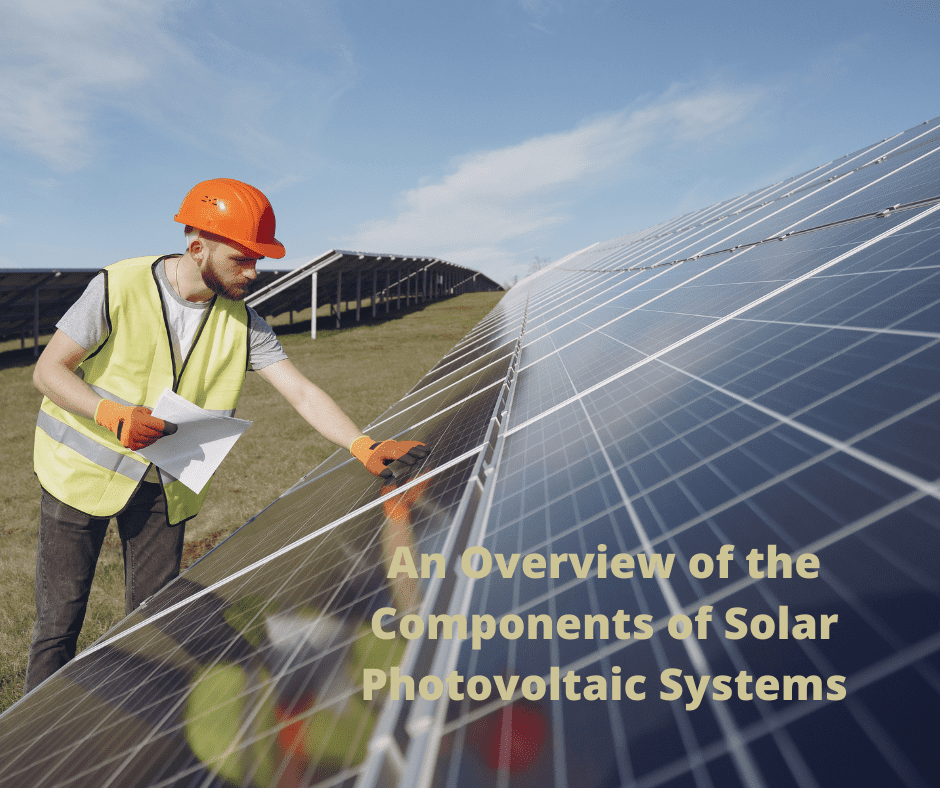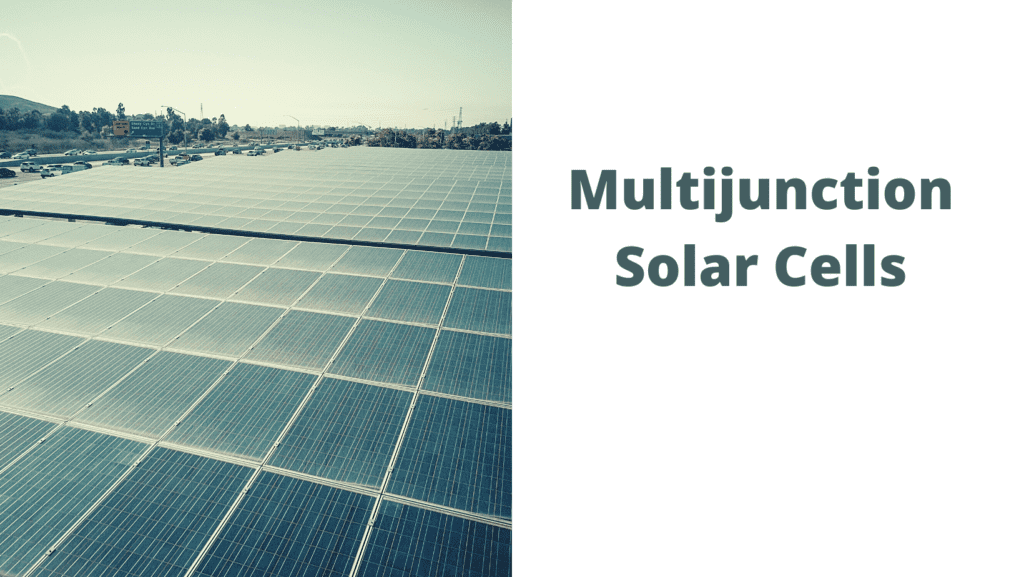Solar Photovoltaic
An Overview of the Components of Solar Photovoltaic Systems

The transformation of light into electrical energy is known as photovoltaic conversion. This phenomenon is captured using semiconductor materials. Originally explored in the fields of physics and photochemistry, this process is currently utilized in commercial applications for generating electricity and in photosensor technology.
This article will give you an overview of the components of solar photovoltaic systems. After reading this article, you’ll know how to design and install your solar photovoltaic system.
Cell
A solar photovoltaic cell is a device that converts light into electricity. This is a physical and chemical phenomenon called the photovoltaic effect. This is why solar panels are so popular today. But how do these cells work? Let’s take a closer look. Here are some of the most common types of solar cells and how they work. And more importantly, why are they so useful for renewable energy?
The maximum output voltage is measured by the maximum voltage (VM). It’s always less than the open circuit voltage and is expressed in volts (V) or millivolts. It’s the energy a solar cell can generate in a single day. The output power of a solar cell is proportional to the amount of sunlight it receives. For this reason, a solar cell’s power output depends on its angle to the light.

Module
A solar photovoltaic module comprises a plurality of individual photovoltaic cells arranged in series. While this arrangement allows the individual cells to generate and transmit electricity efficiently, it can also adversely affect the remaining cells in the series. Solar photovoltaic modules are designed with a bypass diode to solve this problem. Bypass diodes are attached to the back of the modules to prevent current from flowing through them when they are shaded or damaged.
The module’s temperature is controlled by regulating its input and output power to maximize the energy generated by the PV cells. The temperature of a module depends on the incident radiant power density, its thermal properties, and how much energy is transferred through it. The main heat transfer paths of a PV module are illustrated in Fig. 8.1. This figure shows the energy flow from the module to the surrounding.
Array
A solar photovoltaic array is an electrical circuit comprised of individual PV cells. A blocking diode prevents electrical current from flowing back through a weaker network, preventing fully charged batteries from draining through the PV array. The blocking diodes are commonly found in PV modules and are included in most solar photovoltaic arrays. The following explains the components that make up a solar photovoltaic array.
PV modules can be connected in parallel or series to increase their output voltage. When connected in series, the voltage from each module is higher, while the current remains the same. The output voltage of the solar photovoltaic array is determined as Vout = 12V + 12V = 24V. To use solar panels for home use, you should follow the manufacturer’s recommendations for maximizing your solar photovoltaic array’s performance.
Bypass Ddiode
The Bypass diode is one of the components of a solar photovoltaic panel. It prevents the voltage of the PV module from falling below a certain level, particularly in cases of partial shade or pollution. Solar panels consist of multiple solar photovoltaic cells connected in series to increase their output voltage. Bypass diodes protect these cells from damaging each other and the photovoltaic string array.
A solar panel may generate about 0.58 volts DC during a single day. If the bypass diode fails, three consecutive modules may switch off. If this happens, the system’s output drops by about one-third. The result is a decrease in the yield even under ideal solar radiation conditions. Moreover, the Bypass diode should be replaced when the photovoltaic array is fully or partially shaded.
Peak DC Voltage
A solar PV system can be designed to produce a range of voltages, including DC, alternating current, and constant. A direct-coupled system, for instance, doesn’t use batteries and is used only during sunny hours. This system is frequently used to power ventilation fans, small circulation pumps, and water pumps. Choosing a good-performing “direct-coupled system” for a PV array is an essential part of the design process. Matching the electrical load with the PV array’s maximum output is essential.
A PV system’s operating voltage depends on several factors, including the amount of solar radiation available. As a result, the maximum open circuit voltage decreases proportionally to solar radiation. As a result, the output current drops from 9.8 A at 1000W/m2 to two A at 200W/m2.
Peak Current Capacity
The peak current capacity of a solar photovoltaic array is the maximum power a system can deliver, and it varies throughout the day. The peak hours of sunlight are the most productive, with the sun’s rays reaching their maximum value around noon. This rated power is measured in megawatts-peak, a measure of a solar photovoltaic array’s maximum output. One industrial facility with 20,000 panels will generate approximately seven MWp.
The Peak current capacity of a solar photovoltaic array depends on the number of cells used. A typical 12-volt photovoltaic panel will produce between 18.5 and 20.8 watts of peak output, with a series arrangement of thirty-six to forty-eight cells. While this power level is enough to charge a typical 12-volt battery, larger panels are available for charging deep cycle batteries. While the peak output of solar photovoltaic arrays may differ, the PV cells themselves are similar. Listed below are some of the common features of different panels.
Hi, I’m David. I’m an author of ManagEnergy.tv where we teach people how to save energy and money in their homes and businesses.
I’ve been a writer for most of my life and have always been interested in helping people learn new things. When I was younger, I would write short stories for my classmates and teach them how to do math problems.
I love traveling and have been lucky enough to visit some fantastic places around the world.

Solar Photovoltaic
Photovoltaic Technology

Photovoltaic technology involves the direct conversion of sunlight into electrical energy, typically through the use of semiconductor materials. This phenomenon, initially explored in the realms of physics and photochemistry, has found commercial applications in generating electric power and developing photosensors. In this discussion, we will explore several key technologies employed in the field of photovoltaics. This piece aims to highlight a selection of these technologies and explain their widespread popularity.
Photovoltaics (PV) gets its name from converting light to electricity, called the photovoltaic effect, renewable energy technology that converts solar radiation into electricity.
Solar photovoltaic (solar PV) cells are made of semiconductor materials, similar to computer chips. When sunlight hits the cell, it knocks electrons loose from their atoms. As the electrons flow through the cell, they generate electricity.
PV cells are often grouped to form modules or panels. In turn, multiple PV panels can be connected to form an array. The more light hits a PV cell, the more electricity it produces.
What is Photovoltaics?
Photovoltaics is the direct conversion of sunlight into electricity. Solar cells are the basic building blocks of photovoltaic systems and are typically made from silicon. Electrons are knocked loose from the atom when sunlight strikes a solar cell, causing an electric current. The free electrons are attracted to the positive side of the cell, and as they flow toward it, they generate electricity.
How Does Photovoltaics Work?
Solar photovoltaics (PV) convert sunlight into electricity. PV cells are semiconductor materials, similar to those used in computer chips. When light hits the cell, it creates an electric field across the layers of the cell. This field causes electrons to flow through the cell, creating an electric current.
What Are the Benefits of Solar PV Panels?
Solar PV panels are a great way to generate electricity for your home or business. They are relatively easy to install and maintain and can provide a significant amount of electricity for a relatively low cost. In addition, solar PV panels can help to reduce your carbon footprint and save money on your energy bills.
The most prominent advantage of PV cells is their clean and green energy.
The main advantage of PV cells is that they provide clean, renewable energy. Solar panels increase your property value in the US. According to a study done by the Lawrence Berkeley National Laboratory, it was found that properties with solar panels sell 20% faster than properties without solar panels. In addition, they also sell for a premium of about 4.1% more than properties without solar panels.
Solar power allows you to stay connected and in control, as it helps keep your home powered during blackouts. A solar system that is properly sized and installed can provide power for most appliances and lights in your home. Solar energy can also help power some of the larger loads in your home, like air conditioners, refrigerators, and freezers.
Solar power systems are easy to install and maintain, as they do not require much maintenance or repairs. Solar energy is an environmentally friendly energy source, producing no emissions or pollutants. Solar power systems are also easier on utility bills, as they have lower operational costs than traditional grid-based systems.
What Types of PV Modules Are There?
There are three types of photovoltaic modules: monocrystalline, polycrystalline, and amorphous. Monocrystalline PV modules are made from a single, large crystal of silicon. Polycrystalline PV modules are made from many small crystals of silicon. Amorphous PV modules are made from a non-crystalline form of silicon.
Multijunction Solar Cells
Unlike conventional single junction solar cells, multijunction photovoltaic cells have more than one PN junction. These cells are comparable to single junction solar cells but deliver higher energy efficiency. This type of cell does have some drawbacks, however. Because light is concentrated on a single pore, it can cause cell heating problems and even damage them. Fortunately, there are fewer toxic alternatives.
A multijunction solar cell works by layering different materials. Light of a specific wavelength does not interact with fabric with a larger bandgap. The cells are made with a transparent conductor, so electrons generated at each layer are collected and deposited. The materials used in the cell are determined by the demands of high-performance optoelectronic properties and lattice-matching.

During characterization, multiple junction photovoltaic solar cells are tested in a steady-state solar simulator. This is a massively expensive device with temporal instabilities of a few percent. It also takes a long time to insert special filters into the simulator. Nevertheless, the process ensures that multijunction photovoltaic solar cells perform well in space-based applications. You can read about these problems in the following paragraphs.
Thin-Film Solar Cells
The production of electricity from photovoltaic conversion of sunlight is a fast-growing industry. The use of thin-film solar cells is rapidly gaining market share from silicon-wafer technology. This article provides an overview of the photovoltaic industry, reviews the concept of photovoltaic solar energy conversion, and discusses the present and future limitations of thin-film solar cell technology. Emphasis is placed on Cu2ZnSe2 and Cu(In, Ga)Se2 solar cells.
The production process of thin-film solar cells involves several steps. First, a conductive ceramic substrate is formed. Next, a metallurgical barrier is formed to block impurities on the substrate and improve light trapping. Then, a p-type doped active layer is deposited from a liquid solution. Finally, the process includes several steps similar to conventional screen-printing solar-cell production.

The most common type of thin-film solar cell is CdTe. First Solar dominates the utility-scale photovoltaic market with CdTe modules. These solar panels use Tellurium and cadmium deposited on glass. The Series 6 module from First Solar should achieve around 17% efficiency. It’s Series 4 modules are capable of peaking at 100 W. For comparison, cadmium-tellurium cells have lower efficiency but are still more reliable and durable.
Encapsulated Solar Cells
The encapsulation layer of organic solar cells can improve their performance compared to conventional silicon-based solar cells. One recent study found that aluminum doped ZnO achieved up to 18% efficiency compared to silicon solar cells. Encapsulation films can also act as encapsulating layers for organic solar cells, providing several benefits. The hole transport materials are essential to the stability of the device. However, the encapsulation layer is not always stable.
The encapsulant provides adhesion between the solar cell and other components of the PV module. An ideal encapsulant is UV and temperature-resistant, optically transparent, and low in thermal resistance. EVA is the most common encapsulant material. This material is available in thin sheets inserted between the solar cells and heated to 150 degrees Celsius until it polymerizes.
The polymer compositions that form the encapsulation layer of organic PV modules are highly versatile. One type of polymer is commercially available Saran F-310, a vinylidene chloride copolymer, and acrylonitrile. Different concentrations of Boron nitride nanotubes (BN-NT) were added to the polymer. The polymer composite films showed excellent optical transparency and thermal stability with increasing BN-NT content.
What’s the Difference between Solar Radiation and Thermal Energy?
There are two types of solar energy: radiation and thermal. Solar radiation is the energy that comes from the sun in the form of light and heat. This type of solar energy can be used to power solar panels, which then generate electricity. Thermal energy is the energy that comes from the sun in the form of heat. This type of solar energy can heat water or air or power a solar thermal system, which then generates electricity.
What About Lifespan of a Photovoltaic Module?
The lifespan of a photovoltaic module is typically around 25 years. However, the module’s performance will degrade over time, so it will not produce as much electricity as it did when it was new. The amount of degradation will depend on the quality of the module and the conditions it is exposed to (e.g. temperature, humidity, etc.).
Will Solar Panels Be Used in The Future?
There is no doubt that solar panels will continue to be used in the future, significantly as the technology improves and becomes more efficient. Solar panels are a renewable resource, which means they are environmentally friendly and can help to reduce our reliance on fossil fuels. They are also becoming increasingly affordable, making them a more viable option for homeowners and businesses. In addition, solar panels can be used to generate electricity even in remote areas without access to the grid.
Why Is Photovoltaic Technology Continuously Evolving?
There are several reasons why photovoltaic technology is continuously evolving. One reason is that the demand for solar energy is increasing as the world looks for cleaner and more sustainable energy sources. Solar panels are becoming more efficient as technology advances, meaning more electricity can be generated from less sunlight. Additionally, the cost of solar panels is falling as production increases, making them more affordable for consumers. Finally, new applications for solar energy are being developed all the time, such as using solar panels to power cars or to provide energy for remote areas.
How Solar Power Technology Benefits Our Society and Environment?
Solar power technology benefits our society and environment by providing a clean, renewable energy source. Solar power can generate electricity, heat water, and power vehicles. Solar power is also a very versatile form of energy, as it can be harnessed in many ways.
There are many benefits to using solar power. Solar power is clean and renewable, so it does not produce pollution or contribute to climate change. Solar power is also very efficient, as it can be used to generate a lot of energy from a small amount of sunlight. Additionally, solar power is very versatile and can be used in many different ways.
Solar power technology provides many benefits to our society and the environment. It is a clean, renewable source of energy that can be used in many different ways. Solar power is an important part of the future of energy, and its use will continue to grow as we look for cleaner, more sustainable energy sources.
Is Photovoltaic Worth It?
The answer to this question depends on many factors, including the cost of installation, the amount of sunlight available, and the efficiency of the photovoltaic panels. In general, photovoltaic is a good investment if you can take advantage of government incentives and have a sunny location with few shading issues.
What Is a Photovoltaic (PV) Device and How Does It Work?
A photovoltaic device is a device that converts light into electricity. It comprises two or more layers of semiconductor material, usually silicon. When light hits the PV device, it creates an electric field across the layers. This field causes electrons to flow from one layer to another, creating,g an electric current.
Conclusion
Thin-film solar cells are becoming more popular due to their lower cost and increased efficiency. While the production process of thin-film solar cells is more complicated than that of traditional silicon-wafer solar cells, the benefits often outweigh the costs. One advantage of thin-film solar cells is that they can be produced using various materials, allowing for greater flexibility in design. Additionally, encapsulation films can protect organic solar cells from the elements.
-

 Sustainable Supply Chain Management2 months ago
Sustainable Supply Chain Management2 months agoManagEnergy Acquires GPST2030.org Domain to Strengthen Commitment to Sustainable Transport
-

 Wind Energy2 months ago
Wind Energy2 months agoHow Much Oil Does It Take To Lubricate A Wind Turbine
-

 Electricity Vehicle2 weeks ago
Electricity Vehicle2 weeks agoThe Future of Electric Vehicles: Trends and Innovations to Watch
-

 Electric Motorbike1 week ago
Electric Motorbike1 week agoCalifornia Electric Motorcycle Laws: A Comprehensive Guide to Riding Safely
-

 Solar2 months ago
Solar2 months agoIn 2009, About What Percent Of U.S. Energy Consumption Was Supplied By Solar Energy
-

 Wind Energy2 weeks ago
Wind Energy2 weeks agoEnvironmental Innovation Turned Deadly: Ocean Wind Turbines Pose Threat to Whales’ Survival
-

 Wind Energy1 week ago
Wind Energy1 week agoRevolutionizing Highways: Wind Turbines Take the Road to Renewable Energy
-

 Solar2 months ago
Solar2 months agoWhy Should We Use Solar Energy Instead Of Fossil Fuels












